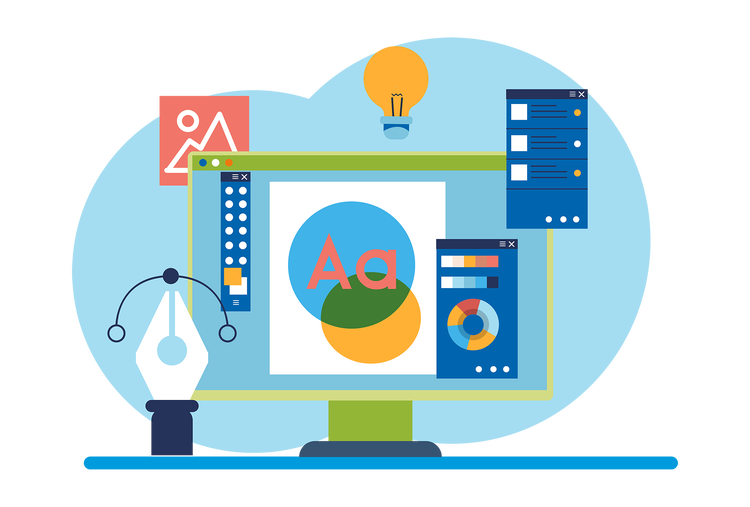How to build a successful content strategy

Overview
Content touches every part of your marketing funnel, from the creative you display with ads through to the leads you drive through organic search. So, your content strategy will have a significant impact on the success of your marketing efforts.
What is a content strategy?
A content strategy ties together your business strategy and the day-to-day tasks that need to happen to achieve those goals. So, whether you need to boost brand awareness or generate more leads (and let’s face it, most businesses are looking to do both), a content strategy can help you put all the pieces in place to do just that. A good content strategy should:
- Reinforce your brand identity and mission: what problem do you solve for your target audience?
- Outline the channels and platforms you use to distribute content
- Show how you plan to research, write, and promote your content
- Lay out the competitive landscape and where your brand stands apart
Get started with our free content strategy template.
From developing your personas to putting everything you’ve planned into a content calendar, our content strategy template will take you through everything you need to do to make content work for your brand or business. The template is available as a PDF which you can then open and edit in Adobe Express. You can also use the PDFs you create in Express with other Adobe tools like Adobe Acrobat.
Building a content strategy: A step-by-step guide.
1. What do you need your content to do?
This is where you decide the overall direction of your content. Why does what you’re doing matter to your wider business? You’ll need to answer a couple of questions:
- What is your business’s overall goal?
- How will your content strategy help you achieve that goal?
In this section, you’ll also add an overview of the strengths and weaknesses of your content strategy, and identify your opportunities and threats. These are external factors that might impact your success such as changes in legislation relevant to your industry.
A crucial step here is adding in the metrics you’ll use to measure success. You might want to use OKRs, where your content objectives directly funnel up to your business’s wider objectives. For every main objective, there will be a set of key results that you want to hit to demonstrate success.
2. Who is your content targeting?
In this section you’ll identify your target buyer or key persona. This is the type of person that is most likely to benefit from what you’re offering, and is most likely to pay for it.
Start by identifying the demographic and behavioural characteristics of your audience. Be as specific as you can with these. The more you can learn about your audience’s shared habits, the more you will understand them. If possible, it’s great to include a mix of market research and qualitative and quantitative customer research.
Characteristics you might want to include:
- Demographics: age; gender; location
- Employment status: role; seniority; industry; company size
- Behavioural e.g., Prefers to operate on mobile
If you undertake customer interviews, consider asking the following questions:
- How did you come across our company?
- What was your first impression of our company?
- When was the moment you realised the true value of what we do?
- What's the problem that we solve for you or your business?
- How do previous companies in our sector that you may have used compare?
- What do you like to read / watch outside of work?
3. Imagery and messaging.
First, give a quick summary of how effective your current messaging is and list opportunities for improvement. For example, does your color palette need updating? Do you have a defined tone of voice?
Next, use the Market Positioning Map to plot your messaging and imagery against your core brand values. Do the same for your competitors. This exercise will help you identify how you can evolve your brand and create a unique voice within the competitive content landscape.

4. How is your content performing?
Before you dive into the stats, think about whether your existing content actually does what you need it to. The questions below will help you think through the purpose of your content, and how close it’s coming to hitting your business objectives.
- Is it clear what someone will get from the content when they click on it?
- Is the promise of what they get before clicking on the content made true by the content?
- Would people be willing to give their email to read this content?
- How does this content help pull prospects down the funnel (towards a purchase)?
- Is this content comprehensive and useful enough to keep people on your site?
- Is this content unique or something you can find anywhere?
- Does the start of the content make people read more?
- Does the content follow your company's tone of voice?
- Does the content have consistent imagery throughout?
Some of the metrics you might want to analyse here include:
- Average time on web pages
- Average bounce rate
- Sign up when landing page is blog URL
- Average scroll depth
- Search impressions / month
- Search clickthrough rate
- Average search position
- Social shares
5. Brand book.
A strong brand makes for more impactful content. Your vision, mission and one-liner are all core to communicating what your brand does and helps you ensure that all your content ladders up to a key business objective. A comprehensive brand book will also save you time as you’ll have a clear understanding of what visual styles and tones of voice you should be using.
This section should include the following:
- Brand vision: where you would like your company to be in 10 years
- Brand mission: what you do for your customers today
- One-liner: your business elevator pitch
- USPs: what sets you apart from the competition
- Tone of voice: How you speak to your audience
- Brand colors and fonts
- Rules for imagery e.g., no more than five colors in one image
6. Promotion strategy.

The better your promotion strategy, the more mileage your content gets. And if you’re putting time into developing a piece of content, why wouldn’t you want to get the most out of it when you promote it?
The promotion strategy section is split up into three different channels: owned, earned and paid. Rather than promoting all your content across all channels, consider a more strategic approach. Promote content you think is good through your owned channels, content you think is great through owned and earned channels, and content you think is brilliant through owned, earned, and paid channels.
Owned channels (where you have full editorial control)
- Your blog
- Social channels
- Video channels
- Podcasts
- Email newsletter
- Email signatures
- Mailshot
- Links from other content
- Site pop ups
- Education guides / email sequences
Earned channels
- Guest posting
- Guest appearances on podcasts
- Ask people to share your content on social
- Ask bloggers to feature and link back to your post
- Seed your content on social groups
- Send your content to influencers that are interested in what you do
- Send to relevant journalists if the news is new and important to your industry
Paid channels
- Promoted social posts
- Sponsored emails
- Influencer paid promotion
- Retargeting ads
- Search ads
- Display ads
- Native advertising
- Offline promotion
7. Campaign strategy.
In the previous section you identified all the channels you’ll use, and when. Now it’s time to identify what campaigns you want to run on those channels.
A campaign can be defined loosely as a themed content launch that touches more than one channel. For example, if you’re launching an online seminar, you’ll want to build a campaign to encourage people to attend and then as part of the same campaign use the content from the seminar to create new content pieces or bitesize videos.
Good campaigns take an idea and turn it into a range of different content types, hopefully with as little as effort as possible.
In this section add details of the campaigns you’d like to run, including objectives and metrics. You can add more details when you are in the planning phase.
8. Calendars.
A campaign calendar, content calendar, and a more specific social media calendar will help you plan and schedule your content production.
9. Wrap up.
Finally, you’ll want to prepare an executive, high-level summary of the contents of your strategy. This should highlight your key content objectives and the core campaigns that will drive success.
What makes a good content strategy?
A good content strategy empowers you to create interesting, relevant content and distribute it through the best channels for your target audience. Writer and editor Erin Kissaine suggests that a content strategy should help you create content that is:
- Appropriate, because it’s what your audience needs
- Useful, because it has a purpose
- User-centred because it is focused on your audience
- Clear, because your audience understands it
- Consistent, because it reflects your tone of voice and mission
- Concise, because who wants to read waffle?
- Supported, because there is a promotion engine to support it
Why use a content strategy?
A great content strategy:
- Makes your business the go-to figure in its field
- Keeps you memorable in a sea of unmemorable content
- Makes people read what you’re posting when they see it in their feed
- Acquires, warms up and converts leads, then keeps them as customers
- Reduces your dependence on paid advertising
Get started today with your free content strategy template.
Having a content strategy allows you to focus on what’s important to your business. Whether that’s more sales, more leads, or more engagement, your content strategy tells you when you’re going off track. You’ll also have a better process for researching, writing, publishing, promoting, and measuring the effectiveness of content.
This post was updated on September 29, 2023.